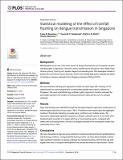Statistical modeling of the effect of rainfall flushing on dengue transmission in Singapore
Author(s)
Seidahmed, Osama Mekki; Eltahir, Elfatih A. B.; Benedum, Corey M.; Markuzon, Natasha
Downloadjournal.pntd.0006935.pdf (1.705Mb)
PUBLISHER_CC
Publisher with Creative Commons License
Creative Commons Attribution
Terms of use
Metadata
Show full item recordAbstract
Background: Rainfall patterns are one of the main drivers of dengue transmission as mosquitoes require standing water to reproduce. However, excess rainfall can be disruptive to the Aedes reproductive cycle by “flushing out” aquatic stages from breeding sites. We developed models to predict the occurrence of such “flushing” events from rainfall data and to evaluate the effect of flushing on dengue outbreak risk in Singapore between 2000 and 2016. Methods: We used machine learning and regression models to predict days with “flushing” in the dataset based on entomological and corresponding rainfall observations collected in Singapore. We used a distributed lag nonlinear logistic regression model to estimate the association between the number of flushing events per week and the risk of a dengue outbreak. Results: Days with flushing were identified through the developed logistic regression model based on entomological data (test set accuracy = 92%). Predictions were based upon the aggregate number of thresholds indicating unusually rainy conditions over multiple weeks. We observed a statistically significant reduction in dengue outbreak risk one to six weeks after flushing events occurred. For weeks with five or more flushing events, compared with weeks with no flushing events, the risk of a dengue outbreak in the subsequent weeks was reduced by 16% to 70%. Conclusions: We have developed a high accuracy predictive model associating temporal rainfall patterns with flushing conditions. Using predicted flushing events, we have demonstrated a statistically significant reduction in dengue outbreak risk following flushing, with the time lag well aligned with time of mosquito development from larvae and infection transmission. Vector control programs should consider the effects of hydrological conditions in endemic areas on dengue transmission.
Date issued
2018-12Department
Charles Stark Draper Laboratory; Massachusetts Institute of Technology. Department of Civil and Environmental Engineering; Parsons Laboratory for Environmental Science and Engineering (Massachusetts Institute of Technology)Journal
PLOS Neglected Tropical Diseases
Publisher
Public Library of Science
Citation
Benedum, Corey M., Osama M. E. Seidahmed, Elfatih A. B. Eltahir, and Natasha Markuzon. “Statistical Modeling of the Effect of Rainfall Flushing on Dengue Transmission in Singapore.” Edited by Robert C Reiner. PLOS Neglected Tropical Diseases 12, no. 12 (December 6, 2018): e0006935. © 2018 Benedum et al.
Version: Final published version
ISSN
1935-2735